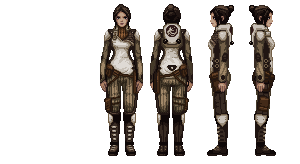Originally this was going to be a postmortem, trying to understand what went wrong with our ambitious, beautiful, doomed project, but candidly I don’t see any point in that exercise. Instead, I want to share with you guys some of what it would have been.
The Sum of Man
The seven sins are all man’s worth,
a fitting match to seas of earth,
the churning, teeming devil’s brew
from which evolved those sinning two,
whose lust ten generations bore
until the One could take no more.
He rent the firmament asunder,
sending forty days of thunder
to drown his murd’ring, grasping brood,
who, still abiding, grew more shrewd
and so connived fourscore more arks
to spray their seed across the dark.
A thousand worlds were claimed by man,
new bowers where he’d breed his clan,
and thus a star-crossed race would sire,
unsmiteable by flood or fire.
It all actually came together in a working, high-res build with ambient sound, music, dialogue built using our new editor, and so on. (I’ll save the screenshot for a later post.)
So, what happened?
There’s no great explanation. It was a very ambitious project that could succeed only with all of us pulling together in the traces, and that never seemed to happen. For the months we spent on it, most of what I have is hundreds of pages of design, ten thousand emails, a few dozen pictures, a lot of music, and a few invoices. Ultimately, several different things coincided in Vic’s life to create additional challenges, and for a three-month span, I didn’t hear from him at all. (I hear from him occasionally now; he’s mostly doing murals.)
The truth is, independent game making is a tricky thing under the best of circumstances. We probably would’ve been wiser to aim smaller—perhaps with that sequel to Primordia I always refuse to contemplate. But I hope that someday I’ll be able to dust off what I did on Cloudscape and make something of it. If not our beautiful, ambitious adventure game, perhaps at least some kind of a sourcebook for other people to pick over.
The Storm
I dreamed a new behemoth,of wing and eye and claw,a creature wreathed in seething
mistthat poured out from its maw.The thing I dreamed regarded mewith sneering awful mirth,as I in youth once viewed alikemy fellow sons of Earth.In fear I tried to rouse myself,to flee its burning gaze.Yet then I knew I was awake,and stared at naught but haze.The vision was an eidolon,a pipe dream, nothing more.But the pipe is just a boatman,
and the night has awful shores.
Anyway, all is not lost: as it happens, the despair left by
Cloudscape‘s untimely death eventually turned into a surge of energy propelling me to my next project, which I hope to announce very soon.













